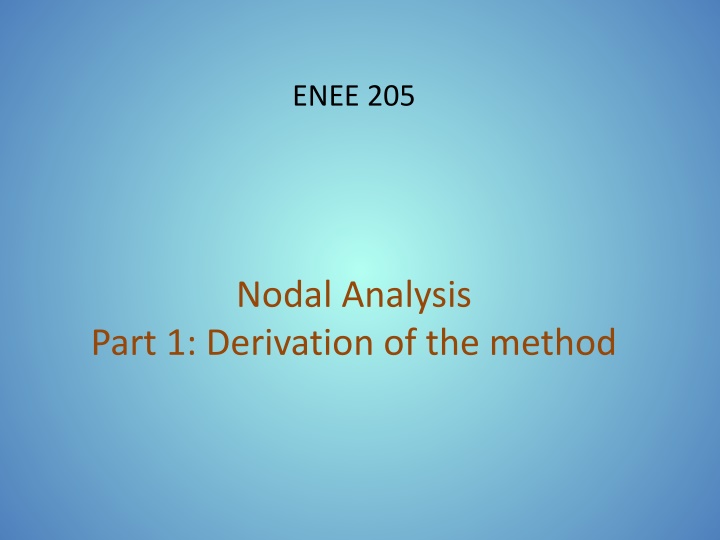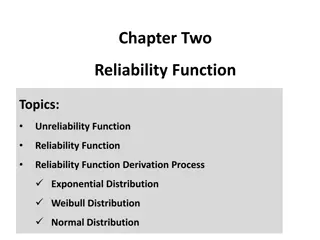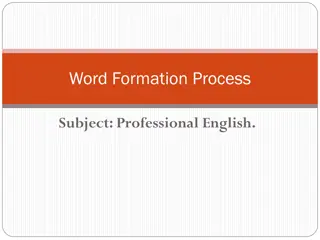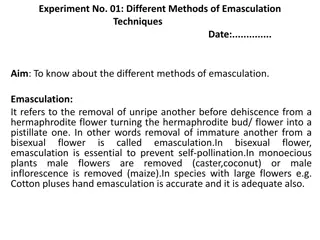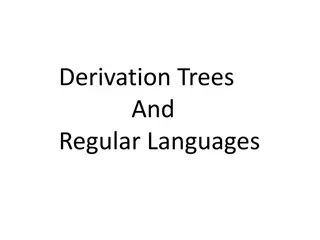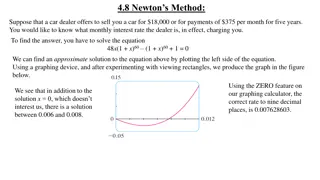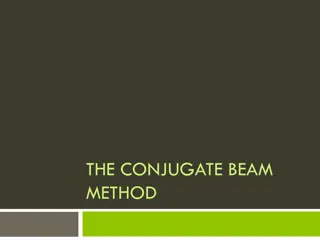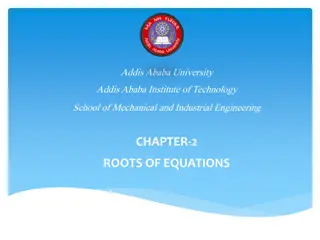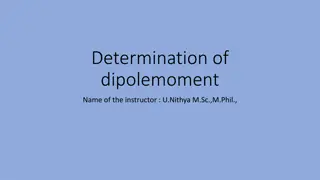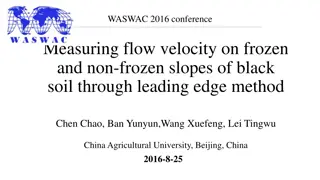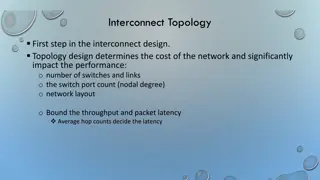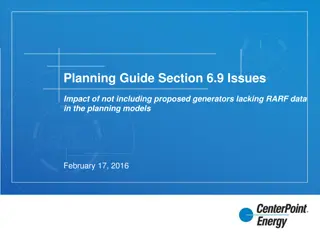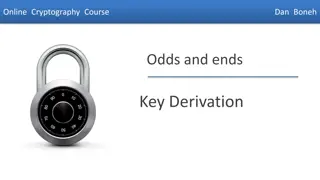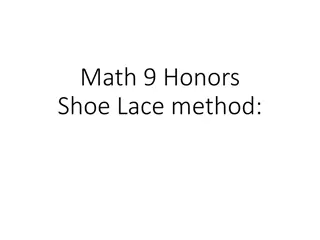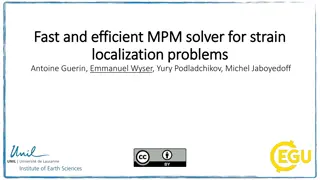Derivation of Nodal Analysis Method
This content covers the derivation of nodal analysis method in electrical circuits, including nodal analysis equations, definitions, and the derivation of the technique through admittances for passive components. It explains the approach, KCL formulation for nodes, algorithm, and matrix representation for solving nodal analysis problems step by step.
Download Presentation

Please find below an Image/Link to download the presentation.
The content on the website is provided AS IS for your information and personal use only. It may not be sold, licensed, or shared on other websites without obtaining consent from the author.If you encounter any issues during the download, it is possible that the publisher has removed the file from their server.
You are allowed to download the files provided on this website for personal or commercial use, subject to the condition that they are used lawfully. All files are the property of their respective owners.
The content on the website is provided AS IS for your information and personal use only. It may not be sold, licensed, or shared on other websites without obtaining consent from the author.
E N D
Presentation Transcript
ENEE 205 Nodal Analysis Part 1: Derivation of the method
Nodal Analysis equations Definitions: Ground a node that we to agree to use as a reference of zero voltage; a node that we define to be at zero volts. Node Potential the voltage difference between a node in a circuit and the reference ground node. Approach: Write KCLs for all nodes except ground. Write currents through the passive components in terms of admittances and node potentials. Organize KLCs in matrix form where the only unknowns are node potentials. Write general algorithm to find matrix elements to bypass KCL evaluation in general.
Derivation of Nodal Analysis Technique Admittances for passive components: ?1= ?1 ?1 ?2= ?2 ?2 ?3= ?3 ?3= ?3 ?1 ?2 ?4= ?4 ?4= ?4 ?1 ?2 Y4 i4 Y3 Node 1 Node 2 i3 i2 + V3 - i1 + + V2 - Isd Isa Y1 Isc Isb Y2 V1 - KCL for Node 1: ??? ??? ?1 ?3 ?4= 0 Or ?1+ ?3+ ?4= ??? ???= ?1 ?1+ ?3 ?1 ?2 + ?4 ?1 ?2 Or ?1+ ?3+ ?4 ?1 ?3+ ?4 ?2= ??? ??? KCL for Node 2: ??? ??? ?2+ ?3+ ?4= 0 Or ?2 ?3 ?4= ??? ???= ?2 ?2 ?3 ?1 ?2 ?4 ?1 ?2 Or ?3+ ?4 ?1+ ?2+ ?3+ ?4 ?2= ??? ???
Derivation continued ?1+ ?3+ ?4 ?1 ?3+ ?4 ?2= ??? ??? ?3+ ?4 ?1+ ?2+ ?3+ ?4 ?2= ??? ??? In matrix form: ?1+ ?3+ ?4 ?3+ ?4 ?3+ ?4 ?2+ ?3+ ?4 The solution is: ?2+ ?3+ ?4 ?3+ ?4 ?1+ ?3+ ?4 ?2+ ?3+ ?4 ?3+ ?42 ??? ??? ??? ??? ?1 ?2 = ??? ??? ??? ??? ?3+ ?4 ?1+ ?3+ ?4 ?1 ?2 =
Nodal Analysis MATRIX (basic n+1 nodes) I . . Y Y Y Y V 11 12 1 1 j n 1 1 s I . . . . Y Y V 21 22 2 2 s . . . . . . Y . ij = I . . . Y Y Y V 1 j ji jj j sj . . . . . . . . I . . . . Y Y V 1 n nn n sn ??? is the sum of the admittances of all passive components connected to node j. ??? = ???is the negative sum of all admittances connected between nodes i and j. ?? is the unknown node potential at node j. ???is the algebraic sum of current sources entering node j.
Nodal Analysis algorithm (BASIC) Step 0 Step 1 get circuit. convert circuit to phasor form use admittances. assign ground; label other nodes. fill out admittance matrix equation. solve matrix equation for unknown node potentials. use node potentials to find any and all currents and voltages in the circuit. Step 2 Step 3 Step 4 Step 5
Step 0. get circuit Nodal analysis example 1 0.5 1 4cos(2t+45 ) A 3cos(2t) A 0.5 H 1 F 1 2 1 Step 1. Convert to phasors and admittances 4ej45 A 3 A -j 2j
Step 2. Assign ground and nodes Node 3 Node 1 1 2 1 Node 2 4ej45 A 3 A -j 2j Step 3. Fill out matrix using prescription ?1 ?2 ?3 2 1 3 + ? 2 1 2 3 3 0 = 1 1 4??45
ENEE 205 Nodal Analysis Part 2: Elimination of trivial nodes
Mandatory Elimination of trivial nodes V1 Y1 Y1 Y1 I1 I1 Y2 I2 V2 V2 V2 I2 Not allowed! ?1?2 ?1+?2 +- ?1 ?1?2 ?2 ?1 ?1+ ?2
1 -j Example with trivial nodes 2 1 2j 4ej45 A 3 A 2 V -j +- 2j 1 ? 2 Combined resistor and inductor in series Converted non-ideal voltage source into current source 1 2 N3 N2 N1 4ej45 A 3 A 4j A -j 2j 2j
1 ? 2 1 2 N3 N2 N1 4ej45 A 3 A 4j A -j 2j 2j 3 ? 2 1 ? 1 2 ? 1 2 2 5 + 3? 2 1 ?1 ?2 ?3 3 0 3 + ? = 4(? ??45 ) 2
ENEE 205 Nodal Analysis Part 3: Circuits with ideal independent voltage sources
Inclusion of ideal voltage sources algorithm Step 0 get circuit. Step 1 convert circuit to phasor form use admittances. Step 2 assign ground; label other nodes. Step 3 fill out admittance matrix equation - pretend for the moment that ideal voltage sources are actually current sources of unknown phasor. Step 4 eliminate unknown(s) in source current column vector by eliminating one row in matrix equation. Step 5 eliminate one column in matrix equation by eliminating one unknown node potential using ideal voltage source. Step 6 solve matrix equation for unknown node potentials. Step 7 use node potentials to find any and all currents and voltages in the circuit
Example 1 with ideal voltage source Step 0 get circuit. Step 1 convert circuit to phasor form use admittances. Step 2 assign ground; label other nodes. N1 N3 1 2 1 N2 3 A +- -j 4 V 2j ?? Step 3 fill out matrix equation - pretend for the moment that ideal voltage sources are actually current sources of unknown phasor. ?1 ?2 ?3 3 0 ?? 2 1 3 + ? 2 1 2 3 = 1 1 Note that ?3 = 4V, so it is NOT an unknown!
?1 ?2 ?3 3 0 ?? 2 1 3 + ? 2 1 2 3 = 1 1 Step 4 eliminate unknown(s) in source current column vector by eliminating one row in matrix equation. ?1 ?2 ?3 2 1 3 + ? 1 2 3 0 = 1
?1 ?2 4 2 1 3 + ? 1 2 3 0 = 1 Step 5 eliminate one column in matrix equation by eliminating one unknown node potential using ideal voltage source. 2 1 1 3 + ? ?2 Step 6 solve matrix equation for unknown node potentials. ?1 7 8 = 3 + ? 5 + 2? 1 5 + 2? 1 29 + 7? 5 + 2? 23 5 + 2? ?1 ?2 5 + 2? 2 5 + 2? 7 8 = =
Example 2 with ideal voltage source Step 0 get circuit. Step 1 convert circuit to phasor form use admittances. Step 2 assign ground; label other nodes (swap ground and N1 for last example). N3 1 2 1 N2 3 A +- -j 4 V 2j ?? N1 Step 3 fill out matrix equation - pretend for the moment that ideal voltage sources are actually current sources of unknown phasor. ?1 ?2 ?3 ?? 3 0 ?? ? ? 3 + ? 2 0 = ? 0 2 3 Note that ?3- ?1 = 4V, so there is one less unknown!
?1 ?2 ?3 ?? 3 0 ?? ? ? 3 + ? 2 0 = ? 0 2 3 Step 4 eliminate unknown(s) in source current column vector by eliminating one row in matrix equation (add lines 1 and 3). ?1 ?2 ?3 ? ? 2 3 + ? 3 3 0 = ? 2
Add columns 1 & 3 ?1 ?2 ? ? 2 3 + ? 3 3 0 = ? 2 ?1+ 4? Also, multiply column 3 by 4V and move to RHS Step 5 eliminate one column in matrix equation by eliminating one unknown node potential using ideal voltage source. 3 + ? ? 2 ? 2 3 + ? ?2 Step 6 solve matrix equation for unknown node potentials. 3 + ? 5 + 2? 5 + 2? ? + 2 5 + 2? 5 + 2? ?1 15 8 = ? + 2 29 7? 5 + 2? 6 7? 5 + 2? ?1 ?2 15 8 = = 3 + ?
Compare answers Calculate voltage across inductor N1 N3 1 2 1 23 Top Circuit: ??= ?2= 5+2? N2 + 3 A -j +- 4 V 2j VL - N3 1 Bottom Circuit: ??= ?2 ?1 = 6 7? 5+2? 5+2? So, there is agreement as there must be! 2 1 29 7? 23 = 5+2? N2 + 3 A -j +- 4 V 2j VL - N1
ENEE 205 Nodal Analysis Part 4: Circuits with dependent sources
Inclusion of dependent sources algorithm Step 0 get circuit. Step 1 convert circuit to phasor form use admittances. Step 2 assign ground; label other nodes. Step 3 fill out admittance matrix equation - pretend for the moment that dependent sources are actually independent sources. Step 4 write dependent source dependencies either in terms of known values (if possible) or in terms of unknown node potentials (if not.) Step 5 move all expressions containing unknown node potentials in the source column vector to the appropriate place in the admittance matrix. Step 6 solve matrix equation for unknown node potentials. Step 7 use node potentials to find any and all currents and voltages in the circuit.
Example with a dependent source Step 0 get circuit. Step 1 convert circuit to phasor form use admittances. Step 2 assign ground; label other nodes. Step 3 fill out admittance matrix equation - pretend for the moment that dependent sources are actually independent sources. N1 N3 1 2 1 N2 + 3 A -j 3 ?2 2j VL - ?1 ?2 ?3 3 0 2 1 3 + ? 2 1 2 3 = 1 1 3 ?2
Step 4 write dependent source dependencies either in terms of known values (if possible) or in terms of unknown node potentials (if not.) ?1 ?2 ?3 3 0 2 1 3 + ? 2 3 1 2 3 = 1 1 3 ?2 Step 5 move all expressions containing unknown node potentials in the source column vector to the appropriate place in the admittance matrix. 2 1 1 1 3 + ? 2 1 5 3 ?1 ?2 ?3 3 0 0 =
ENEE 205 Nodal Analysis Part 5: The Probing method
The probing method algorithm Basic Idea: When you want to find the Thevenin Equivalent source at a pair of terminals, 1. Add a probing current or voltage source across the terminal pair. 2. Calculate the relationship at the terminals between phasor voltage and current for the circuit using some technique (like node or mesh analysis). 3. Find the equivalent non-ideal source parameters (that give the same relation between voltage and current when the probing source is attached to the equivalent non-ideal source). There are four different possible cases: when the non- ideal source is a current or voltage source and when the probing source is a voltage or current source. This technique can be used for any Thevenin / Norton problem, but is particularly useful when the original circuit has dependent sources.
Probing method variations Probing voltage source to find Norton Equivalent Probing current source to find Norton Equivalent Probing voltage source to find Thevenin Equivalent Probing current source to find Thevenin Equivalent Ip Ip + Vp - + Vp - + Vp - + Vp - Original Circuit Original Circuit Original Circuit Original Circuit Ip Ip Vp = Ip Ip = Vp Vp = Ip Ip = Vp YNO = 1/ INO = YNO ZTH = 1/ VTH = ZTH YNO = INO = ZTH = VTH = Vp = (INO Ip)/ YNO Ip = (VTH - Vp )/ ZTH Vp = VTH - Ip * ZTH Ip = INO Vp* YNO ZTH ZTH Ip Ip + Vp - + + Vp - + Vp + + Vp - Ip Ip INO VTH - INO YNO VTH - YNO -
Probing method example AV3 AV3 Z1 Z2 Ip Z1 Z2 +- +- + V3 - + V3 - Vs1 Vp Vs1 Ip GV3 GV3 Use Mesh Analysis to find: Ip = Vp Use Nodal Analysis to find: V3 = Ip INO = ZTH = VTH = YNO = V3 = VTH - Ip * ZTH Ip = INO Vp* YNO ZTH Ip + Vp + + V3 - Ip INO YNO VTH - -
z1 z2 AV3 + - + +- Ip V3 Vs1 GV3 - Convert non-ideal voltage source to non-ideal current source. Y2 + Y1AV3 Y1Vs1 Y1 Ip V3 GV3 -
Y2 N1 + Y1 Ip V3 Y1Vs1 GV3 Y1AV3 - ?1 ?3 ?1??1 ?1??3+ ??3 ?? ?1+ ?2 ?2 ?2 ?2 = ?1 ?3 ?1??1 ?? ?1+ ?2 ?2 ?1? ?2 ? ?2 =
Use Kramers Rule to solve for V3 ?1+ ?2 ?2 ?1+ ?2 ?2 ?1??1 ?? ?3= ?1? ?2 ? ?2 ???1+ ?2+?1?2??1 ?2 ?1+ ?2 + ?1? ?2 ? = = ???1+ ?2+?1?2??1 ?2?1+ ?1? ? ?1?2 ?1?2 ?3= ???1+ ?2+??1 1 + ? ?1?
Read off Thevenins quantities ?3= ???1+ ?2+??1 1 + ? ?1? ??1 1 + ? ?1? ?? = ??? ????? So ???= These answers agree with those calculated in the previous lecture! = ?1+ ?2 1 + ? ?1? = ??1 ?1+?2 1+? ?1? 1+? ?1? and ???=
